A Whale of a trip:
Fishing at Lac Champdoré in northern Quebec
By Troy W. Ketela, Cambridge, MA
The following article is a recap of the fishing
that I and three other fly fishers experienced
at Camp Champdoré in northern Quebec during the
week of July 14-21, 2004. I've broken the text
up into a day-by-day account of our trip so that
the reader might more easily follow the numerous
locations that we fished and the variety of species
that we caught.
WEDNESDAY
As we stood on a dock in Labrador city watching
the pilot pack our gear into the tail of the 50
year old deHavilland Beaver, I marveled at the
fact that we were about to travel yet another
couple of hundred of miles further north. Our group
(Howard, Terry, Don and myself) had spent the previous
night in Labrador City after flying in a series of
jumps from Montreal. Each stop saw our Dash-8
turbo prop empty further and further, until only
a handful of passengers, us and a small group of
mining company executives, made the final flight
from Septs Iles to Wabush (the town adjacent to
Labrador City).
As the Beaver taxied around the lake while the
pilot filled in his flight information, we
passengers excitedly and somewhat nervously
awaited takeoff. This Beaver had clearly seen
over five decades of bush service, and the pilot
had jovially informed us that she was nick-named
"The Donkey" for her mysterious inability to
climb strongly. Soon enough we were safely
(if somewhat slowly) airborne, flying at 1500
feet to keep under the rain clouds. At this
altitude, we were able to see great detail in
the landscape - seemingly endless miles of
ancient Canadian shield, lichen, stubby pines,
sand, water, and even snow banks (on the 14th
of July!). One other feature that was visible
from the air were countless thousands of caribou
migration trails. A veritable spider web of
these trails covered the tundra and taiga, worn
into the landscape by the passage of millions
of caribou over thousands of years. An hour
later we banked steeply and gently landed at
Schefferville, a former iron-ore mining town
now the site of a native reservation and
float-plane base. After loading supplies for
the camp and topping up the fuel tanks, we lifted
off into a now sunny and warm sky. Forty five
minutes later we descended to our final destination:
Lac Champdoré.
We were warmly greeted at the dock by our hosts
and guides for our visit; the Gabriel family. We
later found out that the Gabriels, members of the
Montagnais first nations community, had called
the Champdoré region home for several generations,
and that the elder Gabriel, Grégoire, had been
born on the shores of Lac Champdoré. The main
camp consists of a several simple sleeping cabins
and a pleasant dining cabin in a cleared area on
the lakeshore. The camp has a wonderful view of
the lake and the peaks of twin ancient mountains
across the water. Power is provided by a gasoline
generator and propane. In addition, the ingenious
Grégoire has recently installed a solar power system
which reduces the camp's reliance on the gas-powered
generator.
The outflow from Lac Champdoré forms the Whale River
(Riviere Baleine). From it's headwaters at Champdoré,
the Whale winds its way north through the landscape,
eventually emptying into Ungava Bay. Our group had
been lured to the upper Whale by tales of tremendous
fly fishing opportunities for a variety of species,
including lake trout, brook trout, Ouananiche
(landlocked salmon), and northern pike. My personal
goal was to land a lake trout of 20 pounds or better
on my fly gear, something entirely possible (or even
probable if reports were to be believed) on a trip
to this region. We had timed our trip for the 3rd
week of July in an attempt to coincide with the onset
of heavy caddis and mayfly hatches. Ice-out in this
region typically occurs in mid June, but it had been
a wet cool spring this year and the ice had receded
late, leaving higher than normal water levels when
we arrived.
The fishing season at Champdoré essentially spans
two months; July and August. My research told me
that typically in the first half of the season,
huge lake trout in shallow flowing water are
accessible to fly anglers, and later in August
when lakers become scarcer, the brook trout
fishing really heats up. Pike are around pretty
much right through the season in the shallower
and slower margins of the river. Ouananiche are
phantom ghosts, their movements hard to predict,
although generally the best fishing for the
larger ones coincides with the best lake trout
fishing. The finest fishing opportunities
generally occur at the bases of the numerous
large rapids in the river, and at moving water
confluences far up the lake. Because several
of the large rapids on the river cannot be safely
shot with boats, and to provide variety in water
and scenery for anglers, Champdoré has many boats
with motors and fuel cached in various locations
throughout the watershed.
We unloaded and unpacked our gear from the plane
as quickly as possible, anxious to hit the water.
We grilled the departing guests, a father and son
team, on their experience during the preceding
week. We were elated to hear that they had
experienced amazing fishing, although we were
slightly dejected by the news that no insect
hatches had been witnessed.

The main camp on Lac Champdoré.
Grégoire and his grandson James would be our
guides for the week, each of them leading a
pair of anglers. All six of us loaded into
a massive wooden freighter canoe and we motored
across the bay to the far shore. For the next
few hours, we waded near shore in swift, shallow
flows above the raging rapids of the lake outflow,
prospecting for trout and salmon. While fishing,
I saw many rises out of casting range, out near
the middle and far (camp) side of the flowing
lake narrows. I was tremendously excited by
the observation that the gap between the dorsal
and tail fins on some of those rising fish
appeared to easily exceed 24 inches; truly large
trout! In the end, we only caught a few smallish
brookies before packing it in and heading back to
camp for dinner.
THURSDAY
The next morning we loaded the freighter canoe
and again crossed the bay. Instead of fishing
above the rapids, we followed a trail along the
river for roughly a mile and a half, bypassing
the raging whitewater. After 40 minutes of
walking through the damp forest of ancient,
aromatic pine trees that line the river bank,
we emerged into a clearing at the base of the
rapids where a pair of 16 foot aluminum boats
with motors had been stashed. We split up into
groups of two fishermen and one guide per craft
and then motored out into the roiling water,
and up to the base of the rapids where we could
anchor in small eddies and work the surrounding
swift flows.
Terry, my partner for the day, was quickly was
into a nice pike of around 8 pounds. Shortly
after releasing that first fish, he was straining
against the pull of a strong 10 pound lake trout
in fast water. We were rigged with 8wt rods and
changed lines between floating, sink tip and full
sink lines as we worked the current seams and
bottom pockets. Large, flashy streamers were
the fly of choice. True to the words of the
departing sports who we had quizzed on the
dock the previous day, we saw no insects on
the surface of the river (although the mosquitoes
and black flies were maddening, prompting a few
of us to don head nets). Later, while taking
a rest in the bow of the boat, deeply breathing
the fresh air and letting the stress of city
life pour out of me, I watched Don and Howard
land several large lake trout from the main
current seam in the middle of the river. I
wondered if it could get any better than this...
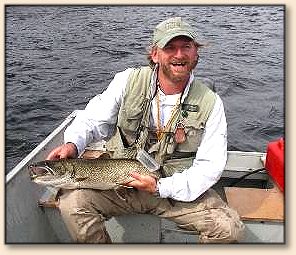
Terry with his first lake trout of the trip.
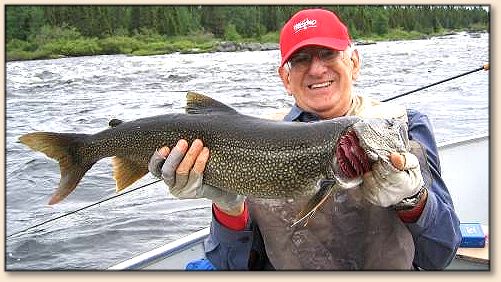
Don with a nice laker from the base of the rapids.
Sensing my frustration at not frequently hooking
up, James suggested that we try a pike spot on
the river for variety. We motored over to the
far side of the river into a shallow flow and
dropped anchor. Knowing that we were
intentionally casting to pike, I switched to
a wire leader and a very large deceiver. In
very short order, Terry and I boated and released
fully a dozen toothy pike ranging from 6 to 10
pounds in size. It was a blast to stand in the
boat and watch the pike zoom out of nowhere and
hammer the large streamers in water that in most
places was only up to our knees or waists. Now
that I had a few fish under my belt, I was
feeling better.
All morning, the wind had been gusting fiercely,
straight up the river into the rapids. As the
afternoon began, low dark clouds settled in,
the breeze diminished and the chop on the flats
below the rapids disappeared. Looking downstream,
I spotted a couple of rises in the calm water of
the wide flats. Tired of pike and desiring trout,
I suggested that we pull anchor, switch out the
wire leaders and pike flies for lighter tippet
and smaller streamers, and go exploring. As
we drifted down river past the area where I had
seen the rises, a 10 pound lake trout nailed the
small streamer I was casting. I had heard that
Champdoré lakers were immensely strong and had
a propensity to make long runs when hooked.
That certainly proved to be true. These far
northern lake trout seemed to have much more
vigor than their southern cousins that I was
familiar with; some lake trout even jumped
while hooked!
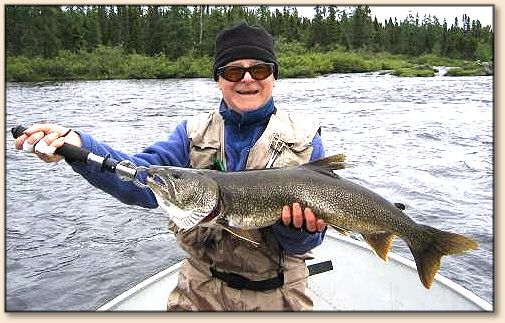 Shallow water laker trout in July - great fun on a fly rod!
Shallow water laker trout in July - great fun on a fly rod!
Further on, I spotted another series of rises
and asked James to drive us over to them. What
followed in the next few hours was some of the
most memorable, exciting fishing I've ever had.
While we drifted and then later anchored in the
calm flats downstream from the rapids, pods of
sizable Ouananiche swam past the boat and rose
around us within easy casting distance. The fish
were working a fertile midge hatch that was
occurring over an area of soft river bottom.
We knew that landlocked salmon are commonly
caught by trolling streamers, but we preferred
to try to take them by casting. For about an
hour, Terry and I tried a variety of different
types of flies and retrieves while attempting
to entice the rising fish. We had dismal success
with everything we tried, and eventually decided
to give up. As we started to slowly motor away,
I began retrieving a streamer that lay out at
the end of a long, bowed line. When the fly
accelerated as the line swung around to straighten
out behind the boat, a 5 pound Ouananiche smashed
it and went airborne. Eureka!
We quickly returned to the pods of rising fish,
anchored, and began casting near rise forms in
the direction that we thought that the cruising
Ouananiche were headed. As soon as the fly
struck the water, we'd furiously strip the
fly, just like we were working a bunker fly
in the salt to blue fish. Every once in a
while, we would accurately predict the
direction that a rising fish was swimming,
the fly would land in front it, the fish
would see it, and a wide V-wake would disturb
the surface as the salmon streaked after the
fleeing streamer. Hook-up almost invariably
resulted in the fish getting wildly airborne
several times. True adrenaline-junkie freshwater
fly fishing! In all, Terry and I caught and
released a dozen and a half nice Ouananiche
with this technique before the hatch petered
out and the fish moved away.
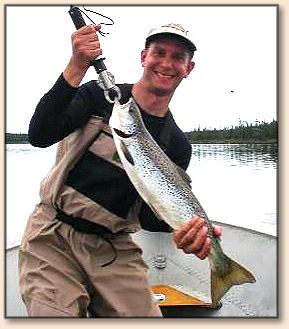
One of the many hard-fighting Ouananiche we caught on Thursday.
FRIDAY-SATURDAY
Early Friday morning, our group loaded into
two freighter canoes for a 30 mile trip up
the lake to its main inflow. After a 90
minute ride up the mirror-smooth main lake,
we began to encounter narrow, shallow channels
with substantial current. We stopped at
several of these narrowings to cast. Some
sites rewarded us with a few smaller fish,
but we failed to find an area with numerous
and or sizable quarry. The fish populations
in the Champdoré watershed tend to migrate
throughout the season. Angle in a particular
area in a given week and you might not find a
single brookie, laker or salmon. Come back a
week or two later, and you may land a fish a
cast. Furthermore, the fish tend to school by
size, so the average size of fish you catch can
change dramatically from place to place, or over
time at the same location. Evidently, we hadn't
quite hit the right time for these particular
flows yet.
Since we were so far away from the main camp,
we had brought supplies and sleeping bags and
planned to sleep in an outpost shelter that
the Gabriel's had erected on a sandy shore
dubbed "Miami beach." To our chagrin, we
found that the outpost had been raided and
trashed by a bear. The unruly bruin had
ripped the door off the shack, overturned
the stove, and failing to find food for his
trouble, shredded the foam sleeping mattresses
out of spite.
Over dinner, Grégoire explained that the next
day we would motor an hour further up to his
'secret' spot, where he assured us we'd get
into a lot of brook trout. After eating, we
crawled into our sleeping bags and tried to
get comfortable on the bare plywood bunks.
Packed into the small shelter on a scenic
sand beach with a make-shift door to keep
the neighborhood bears and mosquitoes out,
the bunch of us drifted off to sleep with
the scent of burning mosquito coils, the
sound of each others exhausted snores, and
with thoughts of plentiful brook trout trying
to squeeze out the thoughts of bearanoia.
After a hearty breakfast, we climbed back
into the boats and worked our way further
up the lake to the confluence of Lac Champdoré
and Lac Tudor. James led Howard and me through
dense brush along the short river to a spot at
the head of the outflow from Lac Tudor while
Terry and Don fished the middle section of the
run. For the next couple of hours, I worked a
plunge pool and the current immediately above
it while Howard fished 50 meters above me at
the head of the run. Although the brook trout
I caught weren't huge (they averaged ~2.5lbs),
they displayed beautiful coloration and were
dogged fighters on a 5wt. Close to noon, James
asked me to not release the next few fish as it
was time for a shore lunch. It was an easy request
to fulfill as I had already caught nearly 20
brookies from the pool and was still hooking
fish.
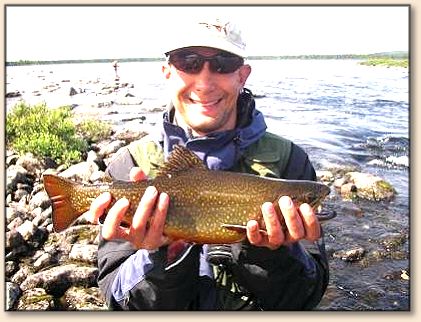
An example of the dozens of colorful brookies
I caught at the Lac Tudor outflow.
After a sumptuous meal of just-caught fried trout,
we returned to the area to fish for a few more
hours. In the warmth of the afternoon sun, a
small hatch of caddis had begun. To my amazement,
some fish were not just rising to the fluttering
insects, but were clearing the water three to
four feet in cart-wheeling jumps. The scene
resembled a school of salmon trying to clear a
waterfall during the spawning run up a river.
Clearly the hatching caddis had excited the
brook trout! The next two hours of dry fly
fishing produced well over a dozen brookies,
the largest about thee pounds. James, slightly
disappointed by what I thought of as great
fishing, informed me that the "big fish"
clearly weren't in yet, and that I was just
catching little guys compared to what they
usually got at that spot. It was true that
my fish weren't as large or numerous as the
12 dozen five to six pound brookies that one
angler and his friends I had consulted for
his Champdoré experience encountered on the
water one afternoon on a previous trip, but
it was great fun nonetheless.
At the beginning of the long ride back to the
main camp, we passed through a couple of
shallow areas and observed that a good Hexagenia
hatch had begun. Clearly, the insect life in
the watershed was really starting to "wake up."
This bode well for the dry fly fishing
possibilities for our remaining fishing days.
At the moment though, I was feeling disconsolate
from the fact that we had to leave immediately
in order to safely make it back to the main camp
before dark. I had heard tales of tremendous
dry fly fishing for huge lake trout during the
Hexagenia emergence in these shallow moving
water confluences, and wanted to experience it
first hand.
SUNDAY
After a few hours of deep sleep, my digital
watch alarm woke me at 4:00am. I roused Terry
and Howard, and we quickly dressed. We grabbed
our gear and walked from the camp down along
the lake to the outlet of the lake above the
rapids. We had decided that the lake level
had receded enough to try to wading out from
shore above the rapids. All three of us were
rewarded with several fine lake trout ranging
from 6 to 10 pounds and a few small Ouananiche.
As we walked back to camp for breakfast we
reflected that it was a fine start to the day,
and that we would have to return to the spot
in our remaining mornings and evenings.
Wading above the first rapids was tricky but
rewarding in the early morning and evening.
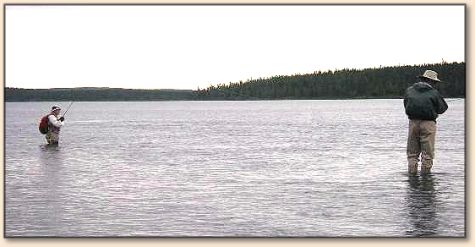
Bent rods like Howard's were a common sight
on our frequent visits.
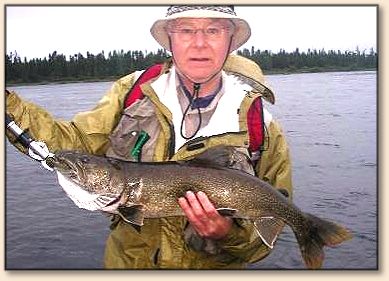
An average early-morning laker. Great fun on
5wt and 6wt rods!
After fueling up with a warm breakfast, we
returned to the river below the first rapids.
Today I fished with Don, who is primarily a
salt-water angler, and hadn't fished much for
trout before. He was interested in pike, and
we spent a few hours casting large flies to
the serpents, reveling in their explosive
strikes that we could observe from our casting
positions in the boat. Later in the afternoon,
a massive hatch of hendricksons started coming
off in the fast water. We motored around
looking for rising fish, and spotted some
salmon down in the flats where Terry and I
had our great success a few days before.
Don hadn't caught a salmon yet and I wanted
to get him into one.
We anchored in a prime spot, and it wasn't
long before we saw the snouts of Ouananiche
breaking the surface all around our boat.
The hatch was very heavy now, and rafts of
mayflies were drifting down from the fast
water down into the flats along current and
wind lines. If previous days had given me
some of the most rewarding fishing, that
afternoon gave me some of the most frustrating
fishing I've ever experienced. Unlike a few
days earlier when the salmon were feeding on
midges, during the mayfly hatch they completely
ignored a streamer. We worked our way through
our fly boxes, trying everything from wet flies
to dry flies to nymphs to streamers, but absolutely
nothing could distract the fish from the naturals.
At times we were surrounded by literally a dozen
simultaneous rises within casting range. This
spectacle produced frantic, frenzied casting
on our part, but no hookups.
After a few hours of this madness, we gave up,
fishless and dejected. The fish were exquisitely
keyed on the mayflies slowly drifting down the
river. I figure that our problem might have
been that the water had very little flow in
that area, and that the fish, focused on the
mayflies to exclusion of all other opportunities,
were randomly cruising around and scooping them
up off the surface. Since the salmon weren't
holding a lie in a current, we couldn't present
a dry fly past one on a drift, and our imitations
of the hendricksons were hopelessly outnumbered
by the heavy hatch when sitting still on the
water. The odds of getting a fish to notice
our dry flies amongst the millions of naturals
were just too slim.
After an awesome dinner of caribou we attempted
to fish a little, but strong winds blew us off
the water. I decided that I wouldn't fish the
next morning as I was teetering on the edge of
collapse from sheer exhaustion. Unfortunately
(or fortunately if you look at it from a health
and welfare standpoint), our supply of gin,
tonic water and limes had run out. I made a
reminder to myself in the margin of my notebook
that next time, we'd have to stock up better on
the necessary supplies before stranding ourselves
hundreds of miles from anywhere then went straight
to bed. Each day we had been fishing with a
vengeance from dawn till dusk then celebrating
and recounting our day's adventures over a few
drinks until late evening, then only sleeping a
few hours, getting up to do it all over again.
Definitely a lifestyle that can only be sustained
for short periods when the fishing is really hot!
MONDAY
The miles and miles of walking were taking
their toll on Don and he had developed
extensive bruising around one of his ankles
from ill fitting boots. He decided that he
needed a rest, so he spent the day exploring
the main lake near camp with James and fishing
for lake trout with spinning tackle. Terry
Howard and I were led by Grégoire and another
one of his grandsons further down the river
to fish the second and third rapids where an
outpost camp had been erected. I had heard
personal accounts of phenomenal brook trout
fishing in this section of the river, usually
occurring later in July and throughout August.
We caught a few very large pike, but after
several hours it became apparent that the
brook trout hadn't yet moved into their
usual haunts for that time of the year. On
our way back to camp, we excitedly noted that
caddis flies were starting to hatch in significant
numbers below the first rapids.
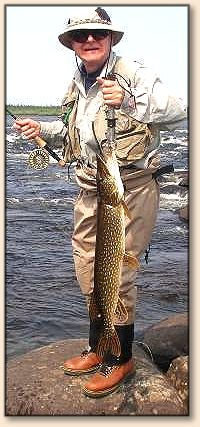
Howard with a brookie-eating machine as
long as his leg, caught below the third rapids.
After dinner, Terry, Howard and I trekked down
to our new favorite spot above the first rapids.
The evening was warm, the wind had disappeared,
and it just felt like it was going to be an
awesome session on the water. Large mayflies
were floating down the river and being slurped
down in big, swirling rises in the slick water
above the rapids. I threaded a floating line
onto my 8wt rod and tied a large parachute
Adams onto a stout tippet. In a short time I
had landed one small Ouananiche and a couple
of decent lake trout. Terry and Howard also
had nice successes, catching a brace of fine
lakers. As the sun got lower, the mayflies
became fewer and farther between but the
mosquitoes got thicker and thicker. As I was
switching to a streamer, Howard packed up and
headed back to camp, driven to distraction by
the bugs.
Before the onset of complete darkness, Terry,
fishing a large floating bomber on a short
stout leader, shouted over to me. I could
see his rod bent in a tight arc, and hear his
reel singing as the line flew through the
guides. After witnessing a long, heroic
battle in the twilight, I assisted Terry by
applying my Boga grip to the lower lip of a
15 pound lake trout, the largest fish any of
our group managed on a dry fly on the trip.
After the Boga grip was firmly around the big
char's lower lip, I bent down to unhook the
fish. I found that the bomber had only lightly
penetrated the roof of the fishes mouth, and
practically fell out when I went to remove it.
How Terry managed to bring that fish it without
the hook coming free, I'll never know! Terry
posed with the fish for a quick picture then
took a break to savor the moment.

Terry with his dry fly-caught laker.
It was getting quite late, but I had a feeling
that with the onset of darkness, the larger
fish had come out to prowl. We agreed that
I should take a few casts before we split
for camp. Two casts later, I felt a hard
slam on my streamer only 30 feet from my feet.
The loose line whipped through the rod guides
then the reel sang as a huge fish ripped out
all of the fly line and 150 feet of backing
in just a few seconds. This was by far the
most powerful fish I had ever felt on a fly
rod, and I have landed many Great Lakes steelhead
up to 15 pounds. The fish surged on a second run,
and we were suddenly disconnected. I reeled in
to find that the frayed 0X tippet was likely a
victim of a sharp rock far out from shore. I
let out a string of profanity at the top of my
lungs then accompanied Terry back to camp,
feeling simultaneously jazzed and dejected.
After we shared the day's fish pictures on
the screens of our digital cameras, I crawled
into my sleeping bag for a short nap, determined
to head back in the morning and land the elusive
20lb lake trout on a fly rod.
TUESDAY
Fighting exhaustion at 4:15am on our last full
day in camp, Terry, Howard and I dressed and
prepared to head back down the river. The lack
of sleep was catching up with us, but knowing
that only a little bit of fishing remained, we
soldiered on. I spent a few minutes wrapping
Terry's wading-booted foot in duct tape before
hitting the water. The sole of his boot had
separated from the upper, creating a dangerous
obstacle to safe wading on the slick rocks at
the head of roaring white water. Fortunately,
no adventurer worth his mettle would be anywhere
without his handy role of duct tape (a nod to
Red Green for all of the Canadians out there!),
and I was able to fashion a temporary repair.
Fishing was good, each of us landing several
decent lake trout and a few Ouananiche. I
spotted a very large lake trout rising close
to shore and quickly fired a cast in front of
it. The laker immediately hit the streamer,
and it's heft felt very similar to that of the
huge fish that I had lost the previous evening.
Instantly after I set the hook, the big trout
peeled towards the middle of the river and up
towards the open lake, seeming to hug the bottom
like a submarine at full speed. As the fish
powered away from me, I could feel the line
rubbing against rocks on the lake bed. The big
lake trout here seemed to intuitively know how
to effectively rid themselves of our flies! I
tried to lift it towards the surface, but it
was too far out, I didn't have the leverage,
and I feared breaking the tippet if I pulled
too hard. Like my previous big fish, this laker
managed to wrap my floating line around several
submerged rocks and break the leader.
It only got worse when ten minutes later, after
re-rigging, I lost another large trout. This
time, I had the fish within touching distance and
could see it clearly in the water, estimating it's
weight at around 15lbs. A very nice fish, but
certainly wasn't as large as the two previous big
ones I'd lost. Just as I was about to slip the Boga
grip over the kype on it's lower jaw, it took off
on another run, taking me into the backing. During
the subsequent battle there was a moment when the
line went slack, and a loop of it wrapped around
the reel handle, binding the reel. The fish picked
that exact moment to surge again and the leader
parted under the immense pressure before I could
figure out why the spool wasn't turning. Although
I felt like insult had been rubbed into injury, I
realized "that's fishing" and no amount of yelling
at the piscatory gods would do me any good. I
reeled up, and followed the guys back to camp
for breakfast.
Our plan for the day was to cross the lake and
make the hike down to the base of the first rapids.
This wouldn't be an easy hike for Don to make
with his swollen foot, but the lure of the caddis
was too great and he managed it in good time.
Terry and I teamed up in the morning, and we
(especially Terry) were rewarded with scads of
smaller Ouananiche rising to caddis in the fast
water immediately below the rapids. Loads of
fun on lighter rods and dry flies! Later, we
moved both boats to a good pike location, and
Don and I started casting mouse patterns. We
each caught several big pike this way, my largest
weighing 12 pounds.
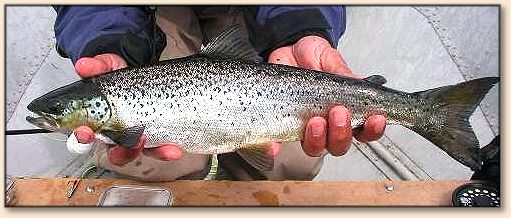
Scores of smaller Ouananiche like this specimen
inhabit the fast water. They love dry flies,
and are a ball on light rods.
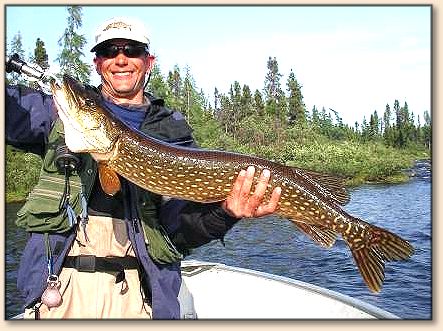
Mouse-eating pike!
Following lunch, we switched up fishing partners
and Howard and I ended up sharing a boat for the
remainder of the day. The caddis hatch was going
very strongly, and we caught a few nice fish.
As the sun began to set, trout and salmon really
began to pepper the surface with rises, slashing
and chasing after the moth-sized caddis as they
taxied and fluttered over the water's surface.
Two of my more interesting fish were an eight
pound lake trout that peeled out my entire 5wt
fly line and 200 feet of backing in one long
continuous reel-screeching run and a 28 inch
Ouananiche, my largest of the trip. I won't
even mention the 15 pound lake trout that I
spotted as it was rising to caddis. I solidly
hooked it, and subsequently lost it after a
long battle when it managed to wrap the leader
around our anchor rope and break off (well ok,
I guess I did mention it). Sadly, we had to
leave the water at the height of the action in
order to safely make the long walk back up river
and the boat ride across the lake back to camp.
You've never seen a glummer set of faces on a
group of fishermen.
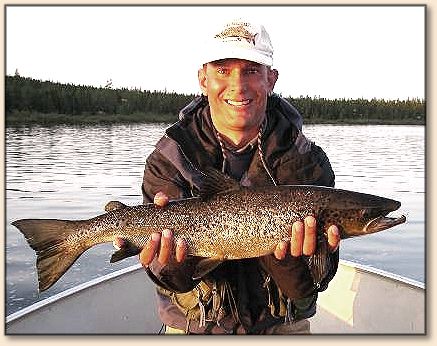
The author's largest Ouananiche of the trip.
WEDNESDAY
Our last morning in camp broke bright, sunny
and cloudless; perfect for taking those last
minute souvenir pictures of the beautiful
surroundings but not so great for fishing.
We dutifully trekked down to our usual haunt
above the rapids, but the big fish eluded us
on this last visit. Terry did catch something
like two dozen small brookies on dry flies in
the shallow side eddies of the rapids while I
managed a pair of small lakers, so all was not
lost. We headed back to camp, packed our bags
and said our last goodbyes to the Gabriel family.
Soon we heard the drone of a floatplane in the
distance. I had a very serious, last minute
internal debate about whether to not get on
that plane. I could have easily stayed for
another week and fished either solo or with a
guide during that fantastic caddis hatch.
Incredibly, no other guests were coming into
camp for the week following our departure. In
the end, guilt about missing work and home life
prevailed, and I boarded the plane, consoling
myself with the thought that "there's always
next year."
In a short time we were on our way back south
on a long direct flight to Wabush. As we cruised
a mile high over the tundra and taiga, I reflected
on my visit to Champdoré. I had experienced some
of the most exciting, most varied fishing in my
life: enormous, pugilistic lake trout in late
July in shallow running water, cart-wheeling
landlocked salmon that would make wakes while
chasing a quickly-stripped streamer, ferocious
pike on mouse flies, and picture-perfect brook
trout by the bushel.
Importantly, we had also experienced a warm,
welcoming stay with the Gabriel family.
Mary-Marthe kept us well fed with hearty meals,
many of which were composed from local ingredients.
She also kept us full of cheer with her sunny
mood and enthusiasm. Grégoire and his grandson
James, both quiet and observant, guided us to
some interesting and spectacular fishing. The
Gabriel family don't see their camp as just a
business, but also as a way to bring people into
their environment and educate them about their
history and culture.
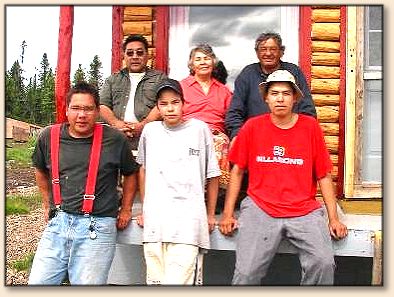
Our hosts - the Gabriel family.
For more information on Camp Champdoré, see their
website at www.champdore.com. ~ Troy W. Ketela
Our Man In Canada Archives
|

